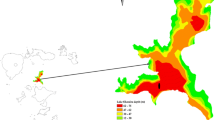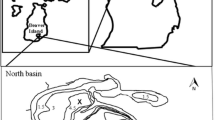Abstract
Bosherston Lakes are a series of interconnected, mesotrophic to hypereutrophic, artificially-created coastal marl lakes in Dyfed, South West Wales. Progressive eutrophication of the lake system has been produced by a high external phosphorus loading which includes phosphorus-rich effluent from a sewage treatment works (STW) in the catchment of the Lakes.
Cores were taken from four sites of varying eutrophic status within the Lakes. In the surface sediment layer, organic C, N and P concentrations generally correlate directly with trophic status and reflect distance from the source of P input. At one site, sediment stratigraphy records a clear transition at 20–15 cm depth, marked by a sharp upward increase in porosity, organic C, N, and P, and ‘iron-associated’-P; decreases in organic matter C/N, C/P and N/P ratios; a sharp decrease in carbonate, and a change in the subfossil diatom assemblage. Lead-210 dating indicates that this change occurred in the period 1919 to 1938.
The diatom stratigraphy and sediment geochemistry suggest that this transition reflects an increase in trophic status at this site, probably as a result of the influx of nutrient-rich water. This took place when the management of the Stackpole estate surrounding the lake system, fell into decline during the period 1919–1938.
Similar content being viewed by others
References
Appleby, P. G. & F. Oldfield, 1978. The calculation of lead-210 dates assuming a constant rate of supply of unsupported 210Pb to the sediment. Catena 5: 1–8.
Aspila, K. I., H. Agemian & A. S. Y. Chau, 1976. A semiautomated method for the determination of inorganic, organic and total phosphate in sediments. Analyst 101: 187–197.
Black, C. A., 1965. Methods of soil analysis. Am. Soc. Agronomy. Monograph No. 9, Madison, Wisc., USA. 1572 pp.
Bortleson, G. C. & G. F. Lee, 1972. Recent sedimentary history of Lake Mendota. Envir. Sci. Technol. 6: 799–808.
Bremner, J. M., 1965. Inorganic forms of nitrogen. In C. A. Black, (op. cit.): 1179–1237.
Brock, T. D., 1985. a eutrophic lake, Lake Mendota, Wisconsin. Ecological Studies 55, Springer Verlag.
Crabtree, K. J. & F. E. Round, 1967. Analysis of a core from Slapton Ley. New Phytologist 66: 255–270.
Keeney, D. R., J. G. Konrad & G. Chesters, 1970. Nitrogen distribution in some Wisconsin Lake sediments. J. Water Poll. Contr. Fed. 42: 411–417.
Lennox, L. J. & M. J. Flanagan, 1982. An automated procedure for the determination of total Kjeldahl nitrogen. Wat. Res. 16: 1127–1133.
Moss, B., 1983. The Norfolk Broadland: experiments in the restoration of a complex wetland. Biol. Rev. 58: 521–561.
Petts, K. W., 1979. The determination of ammonia in estuarine water by autoanalyser. Water Research Centre Technical Report TR 119, 24 pp.
Author information
Authors and Affiliations
Rights and permissions
About this article
Cite this article
Rees, A.W.G., Hinton, G.C.F., Johnson, F.G. et al. The sediment column as a record of trophic status: examples from Bosherston Lakes, SW Wales. Hydrobiologia 214, 171–180 (1991). https://doi.org/10.1007/BF00050947
Issue Date:
DOI: https://doi.org/10.1007/BF00050947




